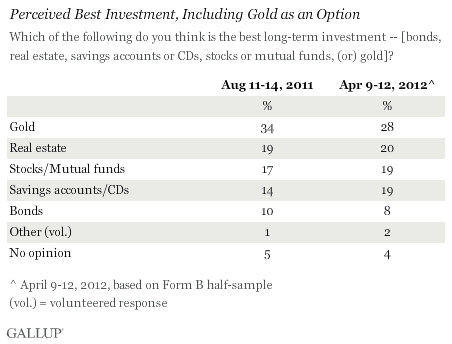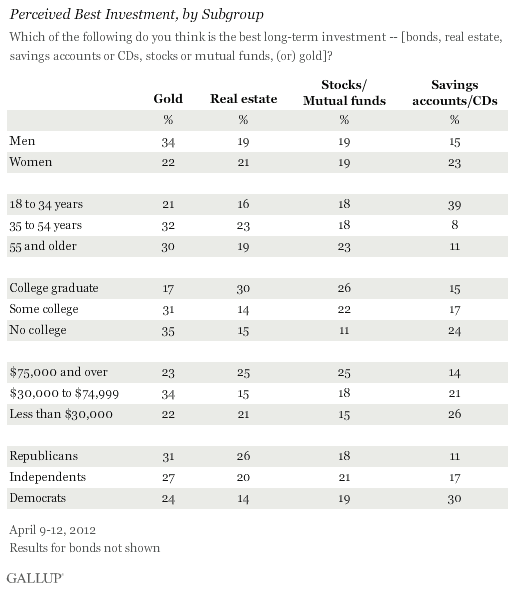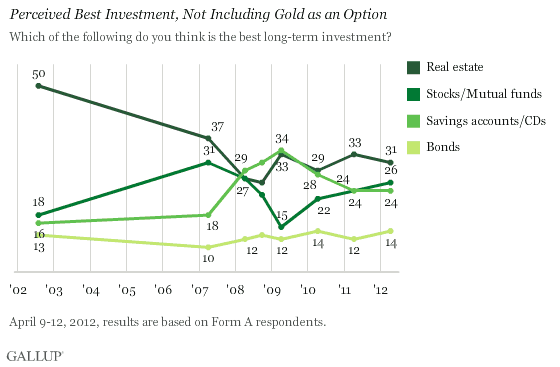PRINCETON, NJ -- Gold leads four other types of investments in Americans' perceptions of which is "the best long-term investment," although the 28% choosing it today is down slightly from 34% in August. Traditional savings accounts or CDs have gained in support over this time, rising to tie stocks/mutual funds and real estate as the next-most-valued investments. Bonds rank a distant fifth.

Gold does particularly well among men, adults 35 years and older, those without a college degree, middle-income Americans, and Republicans. Women, younger adults, lower-income Americans, and Democrats are more likely than others to name savings accounts/CDs as the best investment.

The new findings are from Gallup's April 9-12 update of its annual Economy and Personal Finance poll. The question was asked of a random half-sample of respondents. The other half-sample was asked a longer-term Gallup trend question that does not include gold in the "best long-term investment" choices. That question finds real estate at the top, with 31% of Americans choosing it, followed closely by stocks/mutual funds (26%) and savings accounts or CDs (24%), and then bonds (14%).
These results are similar to those found a year ago, but reflect a decline in support for savings accounts/CDs since 2009, when these peaked at 34%. Longer term, the perceived value of real estate fell sharply between 2002 and 2007, and subsequently dipped slightly further.
Confidence in stocks/mutual funds increased between 2002 and 2007, but then plummeted in 2008 and 2009 before partly recovering since then.

Bottom Line
Investing in gold has gained in popularity in recent years as low interest rates have made traditional savings instruments less attractive, and instability in the stock and real estate markets has undermined the mass appeal of those options. Meanwhile, the rising trajectory of the price of gold over the past several years apparently offers more of the returns and stability investors seek. Although gold prices dipped in the last quarter of 2011 after hitting an all-time high of $1,924 per ounce in September, and have yet to fully recover, more Americans continue to consider gold the best long-term investment among the major options available to consumers.
Survey Methods
Results for this Gallup poll are based on telephone interviews conducted April 9-12, 2012, with a random sample of 1,016 adults, aged 18 and older, living in all 50 U.S. states and the District of Columbia.
Results for the question including gold are based on a random half-sample of 516 national adults and results for the question excluding gold are based on a random half-sample of 500 national adults. For results based on these samples one can say with 95% confidence that the maximum margin of sampling error is ±5 percentage points.
Interviews are conducted with respondents on landline telephones and cellular phones, with interviews conducted in Spanish for respondents who are primarily Spanish-speaking. Each sample includes a minimum quota of 400 cell phone respondents and 600 landline respondents per 1,000 national adults, with additional minimum quotas among landline respondents by region. Landline telephone numbers are chosen at random among listed telephone numbers. Cell phone numbers are selected using random-digit-dial methods. Landline respondents are chosen at random within each household on the basis of which member had the most recent birthday.
Samples are weighted by gender, age, race, Hispanic ethnicity, education, region, adults in the household, and phone status (cell phone only/landline only/both, cell phone mostly, and having an unlisted landline number). Demographic weighting targets are based on the March 2011 Current Population Survey figures for the aged 18 and older non-institutionalized population living in U.S. telephone households. All reported margins of sampling error include the computed design effects for weighting and sample design.
In addition to sampling error, question wording and practical difficulties in conducting surveys can introduce error or bias into the findings of public opinion polls.
View methodology, full question results, and trend data.
For more details on Gallup's polling methodology, visit www.gallup.com.
